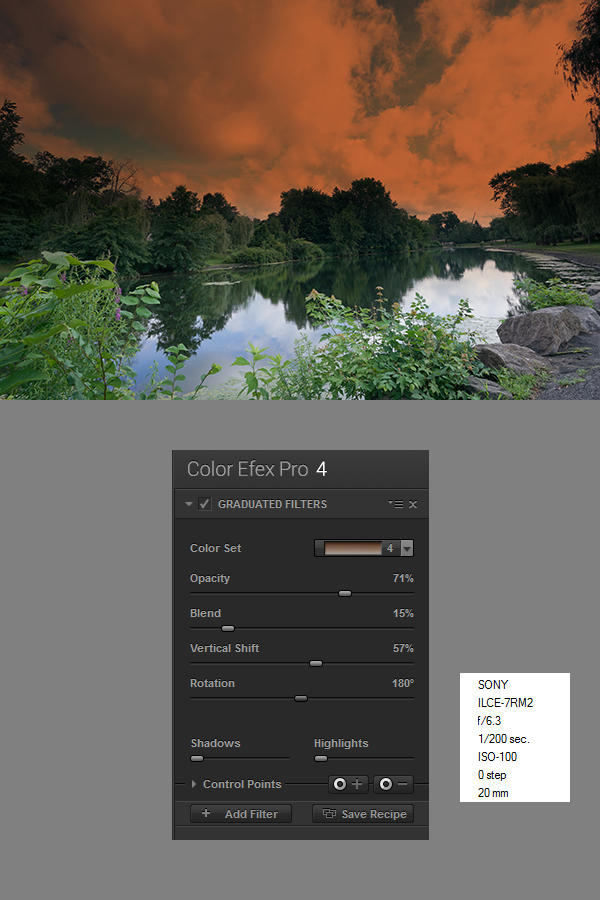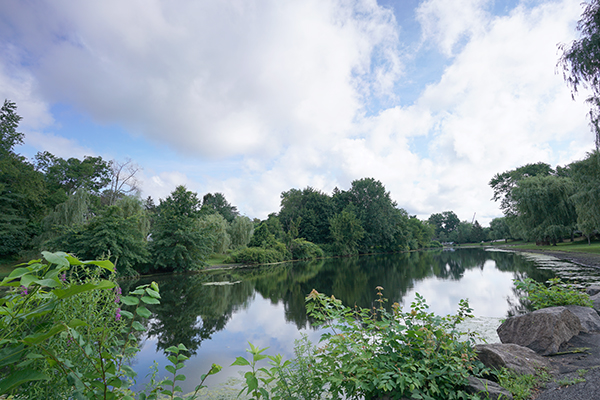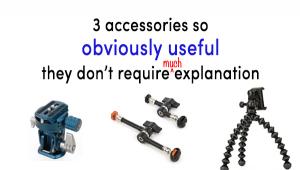$3 Color Graduated Filters: Real Deal or Rip-Off?

It’s Friday and I just ordered a set of 9 color graduated filters from Amazon for $26.59 in 67mm. Cheap, no? Amazingly, the 52mm set is $4 cheaper. Part of me says, “What can you expect from a $3 filter?” But the optimistic little devil sitting on my other shoulder whispers, “How bad can they be?”

If you want to follow along, here’s the link to what I ordered from Amazon: Graduated Color Filters Kit 9 Pieces. The graduated colors are: orange, blue, gray, red, purple, green, pink, brown and yellow. Not exactly ROY G BIV but close enough. Six other sizes are priced as follows.

If camera filters is a new subject for you, read this filter primer we published a couple years back: How To Buy A Filter For Your Camera Lens.
Expectations
Color filters that are used strictly to add special effects don’t have to be perfect. After all, if I’m using a filter to turn the sky pink, does it matter that the clouds look sort of wavy and blah?
Nah.
If the budget-priced filters are clean, unscratched, relatively flat, densely colored and screw in properly, I’m good. Anyway, I can always use another set of coasters.

The Amazon listing states in substandard English (e.g., “…better tightness, no worry fall or loose”) that the filter ring (the threaded part) is “aviation aluminum alloy” and the filter itself is made of “import optics glass and resin.” Not sure what that means exactly, but since glass and resin cannot be compounded, I assume that some are glass and some are resin. But hey, they promise “Give your landscape and skin texture a more colorful touch,” and if there’s anything my skin texture needs about now, it’s a more colorful touch.
(There are at least 100,000 writers out of work right now, but Amazon can’t see fit to hire any of them to proofread and polish product listings. Hello! Many unemployed journalists, poets and especially screenwriters will write for food. I’m just sayin’.)

Eyeglasses are generally made of either polycarbonate or allyl diglycol carbonate, commercially known as CR39 (Columbia Resin 39) a product of Pittsburgh Plate Glass. Cokin filters are made of the later. Read more details about Cokin filters and the interesting history of CR39 material, which was once used to line the fuel tanks of B-17 Flying Fortress bombers, here.
The definition of disappointment is the emotion that pervades when reality fails to satisfy expectations. Or something like that. So I’m aiming low.
I ordered 67mm screw-in size filters because Tamron has done something interesting—and commendable. They’ve standardized the filter size for almost all of the lenses they offer for Sony full frame mirrorless cameras. So I can use the same filter on my Tamron 20mm f/2.8 prime ultra-wideangle and my Tamron 70-180mm f/2.8 telephoto zoom. Very cool. Not only does it save my wallet from buying multiple sizes of the same filter, standardized filter diameters save time and aggravation swapping lens caps when changing lenses.

Reality Bites
I could reach into my equipment closet and grab a handful of Cokin Creative Filters. Tops in my book for special effects, Cokin’s strong suit is graduated colors. Here’s the link to a review of Cokin graduated filters and several examples from 2015 that’s as relevant today as it was then.
Cokin graduated filters are rectangular and slide up and down in the filter holder. You can easily adjust where the color transition aligns in your composition. With screw-in graduated filters, the only way to change the position of the color transition is by tilting the lens up or down. You can rotate the screw-in filters to change the angle of the transition (as you can with Cokin) but you can’t independently change its position relative to the horizon.
So in other words, the reality is I need 9 screw-in graduated filters about as much as I need another 90 cable channels. Or another Eastern Painted Turtle vigorously scratching on my front door to come in for snacks or who knows what—but that’s a story for another time.

Package Arrives
Ordered on Friday, delivered the following Wednesday. Not bad. Amazon predicted a later date. Let’s pick this apart section by section.
Packaging
The nine graduated color filters are each separately wrapped in a cellophane envelope and tucked into one of the 10 mesh-net pockets on the included rollup nylon case. The pack also includes a small microfiber cloth—a nano-size microfiber. The outer (shipping) package is a plastic bag that bears ominous advice: “Save this bag for product returns.”
What do they know that I don’t know?
Construction Quality
I’m impressed. The filter frame is clearly metal (maybe aircraft aluminum, maybe recycled Volkswagen bumpers, who can tell?). The filters can be rotated after being attached to the lens. The thread depth is very shallow, but probably adequate. Altogether they are quite thin, so I expect them to perform well on wideangle lenses without vignetting. We shall see.
The filters are absolutely clean; they’re dust and fingerprint free. I presume that the fabrication and packaging facilities follow very good, careful work practices. The filters must be made of resin, based on their very light weight.
Judging by appearance alone, these filters are clearly worth more than $3 a piece.

The graduated colors are reasonably dense, but three colors— pink, red and orange—look very, very similar. Seen side by side, I can deduce which is which. Separately, I’m not so sure; fortunately, the name of the color is printed on the filter ring. The size of the colored part varies from filter to filter, and that’s not good. I was hoping for a consistent dye pattern across the line.
Performance
Anytime you place a plane of glass or transparent plastic in front of a lens, image performance—in one way or another—is degraded at least slightly. A filter has two flat surfaces, and unless the filter is manufactured to extremely tight tolerances, the surfaces will not be parallel (lack of plano-parallelism in opticspeak). Non-parallel surfaces alter the paths of the light rays and introduce distortions and aberrations. The medium itself, in this case plastic resin, absorbs a small amount of light. And even media labeled “clear” can have a slight colorcast. These and other nefarious malefactors combine to corrupt image quality. Often times, the decrease is so minor that it’s imperceptible. But sometimes it’s conspicuous.

In the final analysis, these filters get a strong “okay.” Optically they’re not bad, considering the price. But the color gradient is uneven and inconsistent. The Gray filter behaves like a graduated neutral density, and that’s okay. The Green filter is more cyan than green. The Yellow and Brown filters are weekly colored and a bit disappointing.
Also, the filter threads are too shallow, as I had feared when I visually inspected them. This is an issue because the filters can be loosened unintentionally when they are rotated within their mount.

10 Tips for Using Graduated Color Filters
1. If you regularly use a UV or 1A filter on your lens, remove it. Ditto the lens shade.
2. Use manual White Balance; otherwise, the camera may neutralize the colorcast you’re trying to add to part of the image.
3. Meter and focus normally. Autofocus should be totally unaffected.
4. The Autoexposure function will automatically compensate for the filter; no changes needed.
5. You can stack one filter over another to color both top and bottom, or to create more dense coloration, depending on how each is rotated. See Tip 6 below, however.
6. If the filter (or stack of filters) is more than 4 or 5 mm thick, it may block light that should reach the corners of the image, thereby creating a vignette effect (also known as “shading”). This unwelcome image corruption is more likely to occur when using wideangle lenses.
7. Slight under exposure increases the effect of the filter, but don’t overdo it.
8. If you use an extremely small aperture, f/32 for instance, a wideangle lens might be able to include part of the filter with the depth of field, causing a distractingly sharp division where the color transitions to clear.
9. If your color-shifted sky, for example, turns out too dull, add some oomph by boosting the Saturation and Exposure in Photoshop.
10. Try some weird stuff—creative filters are fun only if you experiment.

Conclusion
It doesn’t matter how many times I’ve either read it or said it, I don’t practice what I preach. You get what you pay for, especially in a marketplace as competitive as the photo enthusiast industry. But sometimes you get just a little bit lucky.
The overall results are acceptable. On a scale of 1 to 10 I give them a 5.5 for optical performance. In fact, after the first testing series, during which I used each filter for a series of sequential exposures, I was ready to call them a genuine bargain.
“Bargain” has been defined as “something I don’t need at a price I can’t resist.”
Those words were written by Franklin P. Jones (1908-1980). He also said, “When you get something for nothing, you just haven't been billed for it yet.”
These won’t replace my B+W, Cokin, Formatt, Heliopan, Hoya, Lee, Sing-Ray or Tiffen (in alphabetical order, I have a lot of filters) or camera manufacturer-branded filters. That said, for the price I paid they are surprisingly good quality, do what they are advertised to do, and are worth the investment.
If you want to enjoy the same fun experience, order a set from Amazon today. And if you want full immersion into color graduated (and dozens of other creative) filters, take a close look at Cokin.
—Jon Sienkiewicz
(As an Amazon Associate, Shutterbug earns from qualifying purchases linked in this story.)

















































